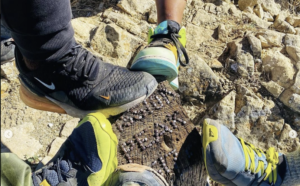Driving over the Carquinez Bridge, you cross a channel where runoff from 40 percent of California gets funneled between two high bluffs. Yet the power and scope of all that water escapes you as you speed across the span. If only you could leave the car behind and set foot on the bridge. Or roll across it at your own pace on a bicycle. Then you’d be able to experience the dynamism of the Sacramento River as it pours into San Pablo Bay.
Well, now you can, and soon you’ll be able to make a grand loop, thanks to a first-ever collaboration between two regional trail organizations, the Bay Area Ridge Trail Council and the San Francisco Bay Trail. The Carquinez Strait Scenic Loop Trail, which is connecting trails north and south of the strait, will be “a microcosm of our larger regional trails,” says Janet McBride, executive director of the Ridge Trail Council, which celebrates its 20th anniversary this year, a year ahead of the same milestone for the Bay Trail. A path for walkers and bicyclists opened on the new Al Zampa Memorial span to great fanfare in 2004 and a path on the new Benicia-Martinez Bridge will open next year, creating the two anchors for the new loop.
When complete, the 50-mile trail will offer the varied terrain of the larger Bay and Ridge trails in a concentrated area: grassy hills, shorelines, marshes, high vista points, oak woodlands, and city parks. “It doesn’t have redwoods,” says Bern Smith, South and East Bay trail planner for the Ridge Trail, “but it takes you everywhere else, from urban areas to those with a backcountry feel.”
The Bay and Ridge trail groups joined forces on the project last year, a move prompted in part because the “alignments on the north side of the strait are identical—this doesn’t happen anywhere else in our trail system,” says Maureen Gaffney, Bay Trail Planner. On the south side, the routes diverge. The Bay Trail continues along the shore, while the Ridge Trail makes a 22-mile swing through upland regions.
The Loop Trail is now more than half complete, thanks to volunteer effort and collaboration between multiple agencies. “In many cases,” says Smith, “volunteers come up with the long-term vision, and they do the bulk of the initial advocacy.” One such volunteer is retired engineer Rollye Wiskerson, who has helped establish and maintain many trails north of the strait since 1989. “I worked at a desk all my life,” he says. “Now I like being outdoors on the trails, as a backpacker and a laborer.”
Volunteers will be key in completing unfinished sections of the trail. One gap is the proposed route across the high windswept terrain of Vallejo Bluffs on the north side of the strait. This section of trail, once completed, will have dramatic views of the surrounding landscape, from Mount Tamalpais to Mount Diablo to the strait itself.
For now, the two-mile Vallejo Bluffs section exists only on paper, but a recently completed feasibility study has moved planning along for what was previously “an intractable section, before both groups put our resources behind it,” says Gaffney. With the route identified, planners can now concentrate on helping cash-strapped Vallejo conduct environmental studies and resolve management issues. When trail construction begins, volunteers— including Wiskerson—will get to work replacing invasive plants with native vegetation. “I’ll be there,” he says. ” I love to get out with the sunshine and the weeds and get dirty.”
Connecting the trail to the Al Zampa Bridge on the north side is another major hurdle, as the route must cross I-80 through an existing underpass, which will require costly modifications.
East of Vallejo Bluffs, the Loop Trail runs through and around Benicia State Recreation Area, a 720-acre park with a mix of shoreline and uplands. A spur follows the shoreline to Dillon Point, a popular fishing spot that looks out across the narrowest portion of the strait.
In the Pinole watershed on the south side of the strait, more than seven miles of trail, about half part of the main loop, were opened to the public for the first time, built by the East Bay Municipal Utility District with the participation of volunteers who helped with planting and fencing.
Close by, two properties owned by the Muir Heritage Land Trust are proposed as critical Ridge Trail links. On Fernandez Ranch, a major trail-building and restoration project will be completed next year, and volunteers will assist in the work. On adjacent Sky Ranch, a two-mile stretch of connector trail was built by 300 volunteers over two days last year.
Though significant challenges remain, the Carquinez Strait Scenic Loop Trail, once finished, will “open up opportunities for people to discover what they may not have known was there,” says Gaffney. They’ll be able to walk or pedal to visit their neighbors across the wide Carquinez Strait, and two visionary regional trail networks will have advanced closer to their goals of encircling the whole Bay Area with accessible and scenic trails.
To learn more about the Carquinez Strait Loop Trail, volunteer opportunities, or trail events, visit the Ridge Trail website at www.ridgetrail.org. Find out more about the Bay Trail at www.baytrail.org.

.jpg)



